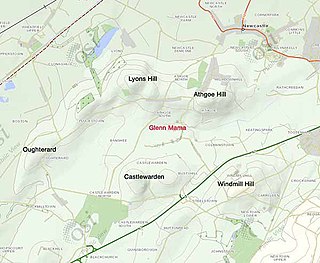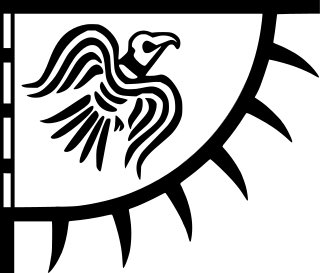
Brian Boru was the High King of Ireland from 1002–1014. He ended the domination of the High Kingship of Ireland by the Uí Néill, and is likely responsible for ending Viking invasions of Ireland. Brian Boru is mentioned in the Annals of Inisfallen and in Chronicon Scotorum as "Brian mac Cennétig". The name Brian of Bóruma or Brian Boru was given to him posthumously Brian built on the achievements of his father, Cennétig mac Lorcain, and especially his elder brother, Mathgamain. Brian first made himself king of Munster, then subjugated Leinster, eventually becoming High King of Ireland. He was the founder of the O'Brien dynasty, and is widely regarded as one of the most successful and unifying monarchs in medieval Ireland.

The Battle of Clontarf took place on 23 April 1014 at Clontarf, near Dublin, on the east coast of Ireland. It pitted an army led by Brian Boru, High King of Ireland, against a Norse-Irish alliance comprising the forces of Sigtrygg Silkbeard, King of Dublin; Máel Mórda mac Murchada, King of Leinster; and a Viking army from abroad led by Sigurd of Orkney and Brodir of Mann. It lasted from sunrise to sunset, and ended in a rout of the Viking and Leinster armies.
Gormlaith ingen Murchada, sometimes spelt Gormflaith, was an Irish queen.

The history of Ireland 795–1169 covers the period in the history of Ireland from the first Viking raid to the Norman invasion. The first two centuries of this period are characterised by Viking raids and the subsequent Norse settlements along the coast. Viking ports were established at Dublin, Wexford, Waterford, Cork and Limerick, which became the first large towns in Ireland.
Sigtrygg II Silkbeard Olafsson was a Hiberno-Norse king of Dublin of the Uí Ímair dynasty. He was caught up in the abortive Leinster revolt of 999–1000, after which he was forced to submit to the King of Munster, Brian Boru. His family also conducted a double-marriage alliance with Boru, although he later realigned himself with the main leaders of the Leinster revolt of 1012–1014. He has a prominent role in the 12th-century Irish medieval text Cogadh Gaedhil re Gallaibh and the 13th-century Icelandic Njal's Saga, as the main Norse leader at the Battle of Clontarf (1014).

The Battle of Glenn Máma or Glenmama took place most probably near Lyons Hill in Ardclough, County Kildare, Ireland, in AD 999 between Windmill Hill and Blackchurch. It was the decisive and only engagement of the brief Leinster revolt of 999–1000 against the King of Munster, Brian Boru. In it, the combined forces of the Kingdoms of Munster and Meath, under King Brian Boru and the High King of Ireland, Máel Sechnaill II, inflicted a crushing defeat on the allied armies of Leinster and Dublin, led by King Máel Mórda of Leinster.
Lyons Hill or Lyons is a townland and restored village in County Kildare. At a time when canal passenger boats travelled at 3 mph (4.8 km/h) Lyons was the nearest overnight stop to Dublin on the Grand Canal. On the hilltop is a trigonometrical point used by Ireland's Ordnance Survey. The name derives from the Irish language name for an elm tree, Liamhan.

Sitric Cáech or Sihtric Cáech or Sigtrygg Gále, was a Hiberno-Scandinavian Viking leader who ruled Dublin and then Viking Northumbria in the early 10th century. He was a grandson of Ímar and a member of the Uí Ímair. Sitric was most probably among those Vikings expelled from Dublin in 902, whereafter he may have ruled territory in the eastern Danelaw in England. In 917, he and his kinsman Ragnall ua Ímair sailed separate fleets to Ireland where they won several battles against local kings. Sitric successfully recaptured Dublin and established himself as king, while Ragnall returned to England to become King of Northumbria. In 919, Sitric won a victory at the Battle of Islandbridge over a coalition of local Irish kings who aimed to expel the Uí Ímair from Ireland. Six Irish kings were killed in the battle, including Niall Glúndub, overking of the Northern Uí Néill and High King of Ireland.

The Uí Ímair, also known as the Ivardynasty or Ivarids, was a Norse-Gael dynasty which ruled much of the Irish Sea region, the Kingdom of Dublin, the western coast of Scotland, including the Hebrides and some part of Northern England, from the mid 9th century.

Máel Sechnaill mac Domnaill, also called Máel Sechnaill Mór or Máel Sechnaill II, was a King of Mide and High King of Ireland. His great victory at the Battle of Tara against Olaf Cuaran in 980 resulted in Gaelic Irish control of the Kingdom of Dublin.
Glúniairn, in Old Norse Járnkné, was a Norse-Gael king of Dublin of the Uí Ímair kindred which ruled over much of the Scandinavianised and Norse-Gael parts of Great Britain and Ireland in the tenth century.
Ímar was a powerful Viking leader in Ireland and Scotland in the mid-late ninth century. He was the progenitor of the Uí Ímair dynasty, who would go on to dominate the Irish Sea region for several centuries. He was the son of the king of Lochlann, identified in the non-contemporary Fragmentary Annals of Ireland as Gofraid. The Fragmentary Annals name Auisle and Amlaíb Conung as his brothers. Another Viking leader, Halfdan Ragnarsson, is considered by some scholars to be another brother. The Irish Annals title Amlaíb, Ímar and Auisle "kings of the foreigners". Modern scholars use the title "Kings of Dublin" after the Viking settlement which formed the base of their power. Some scholars consider Ímar to be identical to Ivar the Boneless, a Viking commander of the Great Heathen Army named in contemporary English sources who also appears in the Icelandic sagas as the eldest son of the legendary Viking Ragnar Lodbrok by third wife Aslaug.
Events from the 9th century in Ireland.
Events from the 11th century in Ireland.
Amlaíb mac Sitriuc or Olaf Sigtryggsson, was the son of Sigtrygg Silkbeard, the Hiberno-Norse King of Dublin, and Sláine, the daughter of Brian Boru. A member of the Uí Ímair dynasty, his ancestors also included Amlaíb Cuarán and Gormflaith, who were influential in medieval Ireland. He was held to ransom by the Gaelic lord of Brega and later killed in England by Anglo-Saxons while on his way on pilgrimage to Rome in 1034. He thus predeceased his father. Some of his descendants later became the Kings of Gwynedd in Wales.

Ivar of Waterford was the Norse king of Waterford from at least 969 until his death in the year 1000, and also reigned as King of Dublin, possibly from 989 to 993, and certainly again for less than a year between 994 and 995, returning after his expulsion from the city in 993 by Sigtrygg Silkbeard, who would expel him for good the next time.
Máel Muire was Queen of Ireland, being actually styled so in the Annals of Clonmacnoise. The wife of Máel Sechnaill mac Domnaill, High King of Ireland, she was a daughter of Amlaíb Cuarán, King of Dublin until 980/1 and formerly King of York. Thus she was a member of the Norse-Irish Uí Ímair dynasty and the first Queen of Ireland of ultimately foreign or non-Gaelic lineage known to be historical. One of her brothers was the celebrated King of Dublin Sitric Silkbeard, while a sister Gytha was wife to Olaf Tryggvason, King of Norway.
The Battle of Islandbridge, also called the Battle of Áth Cliath, took place on 14 September 919, between a coalition of native Irish, led by Niall Glúndub, overking of the Northern Uí Néill and High King of Ireland, and the Dublin-based Vikings of the Uí Ímair, led by Sitric Cáech. It was one in a series of battles initiated by the native Irish to attempt to drive the Vikings of the Uí Ímair from Ireland. The battle was a decisive victory for Sitric Cáech and the Uí Ímair, with Niall Glúndub and five other Irish kings dying in the battle.

The O'Brien dynasty was an Irish Clan and noble house of Munster, founded in the 10th century by Brian Boru of the Dál gCais (Dalcassians). After becoming King of Munster, through conquest he established himself as Ard Rí na hÉireann. Brian's descendants thus carried the name Ó Briain, continuing to rule the Kingdom of Munster until the 12th century where their territory had shrunk to the Kingdom of Thomond which they would hold for just under five centuries.
The Battle of Mag Femen took place on 22 August 917 between the Vikings of the Uí Ímair, led by Ragnall, a grandson of Ímar, and the Irish of the Northern Uí Néill, led by Niall Glúndub, High King of Ireland. It was one of two battles involving the Uí Ímair that year, the other being the Battle of Confey, which occurred as a result of the Uí Ímair trying to retake the Kingdom of Dublin which they had lost in 902. The battle began when Niall Glúndub's forces attacked a Viking army at a site identified by the annals as Topar Glethrach in Mag Femen. The Irish initially inflicted the majority of the casualties, but late in the day a host of more troops led by Ragnall reinforced the Viking army, securing victory for the Uí Ímair.